Resident Crews of the International Space Station (ISS)
![]()
ISS: Expedition 53 |
 |
 |
 |
alternative crew photoalternative crew photo |
|
 |
 |
![]()
Crew, launch- and landing data
| No. | Nation | Surname | Given names | Position | Spacecraft (launch) |
Launch date |
Launch time |
Spacecraft (landing) |
Landing date |
Landing time |
Mission duration |
Orbits |
| 1 | Bresnik | Randolph James "Randy" | ISS-CDR | Soyuz MS-05 | 28.07.2017 | 15:41:12,285 UTC | Soyuz MS-05 | 14.12.2017 | 08:37:47.3 UTC | 138d 16h 56m 37s | 2158 | |
| 2 | Misurkin | Aleksandr Aleksandrovich | Flight Engineer-1 | Soyuz MS-06 | 12.09.2017 | 21:17:02.407 UTC | Soyuz MS-06 | 28.02.2018 | 02:31:06.4 UTC | 168d 05h 14m 04s | 2617 | |
| 3 | Acaba | Joseph Michael | Flight Engineer-3 | Soyuz MS-06 | 12.09.2017 | 21:17:02.407 UTC | Soyuz MS-06 | 28.02.2018 | 02:31:06.4 UTC | 168d 05h 14m 04s | 2617 | |
| 4 | Vande Hei | Mark Thomas | Flight Engineer-2 | Soyuz MS-06 | 12.09.2017 | 21:17:02.407 UTC | Soyuz MS-06 | 28.02.2018 | 02:31:06.4 UTC | 168d 05h 14m 04s | 2617 | |
| 5 | Ryazansky | Sergei Nikolayevich | Flight Engineer-4 | Soyuz MS-05 | 28.07.2017 | 15:41:12,285 UTC | Soyuz MS-05 | 14.12.2017 | 08:37:47.3 UTC | 138d 16h 56m 37s | 2158 | |
| 6 | Nespoli | Paolo Angelo | Flight Engineer-6 | Soyuz MS-05 | 28.07.2017 | 15:41:12,285 UTC | Soyuz MS-05 | 14.12.2017 | 08:37:47.3 UTC | 138d 16h 56m 37s | 2158 |
unofficial Backup Crew
| No. | Nation | Surname | Given names | Position |
| 1 | Vande Hei | Mark Thomas | ISS-CDR | |
| 2 | Shkaplerov | Anton Nikolayevich | Flight Engineer | |
| 3 | Tingle | Scott David "Maker" | Flight Engineer | |
| 4 | Walker | Shannon | Flight Engineer | |
| 5 | Misurkin | Aleksandr Aleksandrovich | Flight Engineer | |
| 6 | Kanai | Norishige | Flight Engineer |
 |
 |
 |
Expedition Report
|
ISS Expedition 53 began with the undocking of
spacecraft Soyuz
MS-04 on September 02, 2017 at 21:58:01
UTC. The former Expedition 52 (Fyodor
Yurchikhin, Jack
Fischer and Peggy
Whitson) returned safely to Earth. Following a six hours solo flight Soyuz MS-06 docked to ISS on September 13, 2017. Aleksandr Misurkin, Mark Vande Hei and Joseph Acaba became the ISS Expedition 53 (together with ISS Expedition 52 crew members Sergei Ryazansky, Randolph Bresnik and Paolo Nespoli). With the arrival Expedition 53 became a six-person-crew. After delivering more than 6,400 pounds (2,900 kg) of cargo, a SpaceX Dragon (CRS-12 or SpX-12) cargo spacecraft departed the International Space Station on September 17, 2017. Flight controllers used the space station's Canadarm2 robotic arm to detach Dragon, which arrived on August 16, 2017, from the Earth-facing side of the station's Harmony module. After Dragon was maneuvered into place, the spacecraft was released by Paolo Nespoli with the assistance of Randy Bresnik at 08:47 UTC. Dragons thrusters were fired to move the spacecraft a safe distance from the station before SpaceX flight controllers in Hawthorne, California, commanded its deorbit burn. The spacecraft splashed down at about 14:16 UTC in the Pacific Ocean, where recovery forces retrieved Dragon and approximately 3,800 pounds (1,783 kg) of cargo. This includes science samples from human and animal research, biology and biotechnology studies, physical science investigations and education activities. On September 27, 2017, an ISS reboost was performed using Progress MS-06 thrusters. This reboost was to set up for the launch of Progress MS-07 on October 12, 2017. The engines started at 16:50 UTC and fired 220 seconds. The ISS got 0.448 m/sec. more speed. The first spacewalk was performed by Randolph Bresnik and Mark Vande Hei on October 05, 2017 (6h 55m). They replaced one of two Latching End Effectors (LEE) on the station's robotic arm, Canadarm2. One of the Canadarm2 grappling mechanisms experienced a stall of its motorized latches last month, but the problem has had no effect on planned station operations. A spare LEE is stored outside on the station's truss. Canadarm2 has two identical Latching End Effectors used to grapple visiting cargo vehicles and payloads, provide data and telemetry to the rest of the Canadian-built Mobile Base System and the unique capability to "walk" from one location on the station's truss to another. On October 10, 2017 Randolph Bresnik and Mark Vande Hei left the International Space Station for a second time (6h 26m). The spacewalkers lubricated the newly installed end effector and replaced cameras on the left side of the station's truss and the right side of the station's U.S. Destiny laboratory. The launch of the unpiloted Russian Progress MS-07 occurred on October 14, 2017 at 08:46:53.478 UTC from the Baikonur Cosmodrome in Kazakhstan. The freighter delivered 2,549 kg of food, fuel and supplies to the International Space Station. A first launch attempt on October 12, 2017 was scrubbed only a few seconds prior launch due to technical problems. The spacecraft docked two days later to the Pirs docking compartment of the space station at 11:04:05 UTC on October 16, 2017. Progress MS-07 spent almost five months docked at the station before departing on March 28, 2018 for its deorbit into the Earth's atmosphere. The third EVA within two weeks was performed by Randolph Bresnik and Joseph Acaba on October 20, 2017 (6h 49m). The spacewalkers devoted their work again to lubricating the newly installed end effector and replacing cameras on the left side of the station's truss and the right side of the station's U.S. Destiny laboratory. On November 02, 2017, an ISS reboost was performed using Progress MS-06 thrusters. This reboost was to set up for Soyuz MS-05 landing planned on December 14, 2017 and the launch of Soyuz MS-07 on December 17, 2017. The engines started at 03:15 UTC and fired 206 seconds. The ISS got 0.42 m/sec. more speed. The actual parameters are 403.3 km x 425.4 km. The ISS needs 92.60 minutes for each orbit. On November 12, 2017 at 12:19:51 UTC Orbital ATK launched its Cygnus OA-8 ("S.S. Gene Cernan") spacecraft on an upgraded Antares rocket from the Mid-Atlantic Regional Spaceport's Pad-0A. This was the eighth planned cargo resupply mission by Orbital ATK for NASA under the agency's $1.9 billion Commercial Resupply Services contract with the company. Cargo resupply from U.S. companies ensures a national capability to deliver critical science research to the space station, significantly increasing NASA's ability to conduct new science investigations to the only laboratory in microgravity. Cygnus carried several CubeSats that conducted a variety of missions, from technology demonstrations of laser communication and increased data downlink rates to an investigation to study spaceflight effects on bacterial antibiotic resistance. Other experiments will advance biological monitoring aboard the station and look at various elements of plant growth in microgravity that may help inform plant cultivation strategies for future long-term space missions. The spacecraft will also transport a virtual reality camera to record a National Geographic educational special on Earth as a natural life-support system. The E. coli AntiMicrobial Satellite (EcAMSat) mission will investigate the effect of microgravity on the antibiotic resistance of E. coli, a bacterial pathogen responsible for urinary tract infection in humans and animals. Antibiotic resistance could pose a danger to astronauts, especially since microgravity has been shown to weaken human immune response. The experiment will expose two strains of E. coli to three different doses of antibiotics; one of these strains is deficient in the gene responsible for the increased antibiotic resistance in microgravity. Results from this investigation could help determine appropriate antibiotic dosages to protect astronaut health during long-duration missions and help us understand how antibiotic effectiveness may be increased in microgravity, as well as on Earth. The Optical Communications and Sensor Demonstration (OCSD) project will study high-speed optical transmission of data and small spacecraft proximity operations. It will test functionality of laser-based communications using CubeSats that provide a compact version of the technology. Results from OCSD could lead to significantly enhanced communication speeds between space and Earth and a better understanding of laser communication between small satellites in low-Earth orbit. The Biological Nitrogen Fixation in Microgravity via Rhizobium-Legume Symbiosis (Biological Nitrogen Fixation) investigation examines how low-gravity conditions affect the nitrogen fixation process of Microclover, a resilient and drought tolerant legume. The nitrogen fixation process, a process by which nitrogen in the atmosphere is converted into a usable form for living organisms, is a crucial element of any ecosystem necessary for most types of plant growth. This investigation could provide information on the space viability of the legume's ability to use and recycle nutrients and give researchers a better understanding of this plant's potential uses on Earth. As space exploration increases, so will the need for improved power and communication technologies. The Integrated Solar Array and Reflectarray Antenna (ISARA), a hybrid solar power panel and communication solar antenna that can send and receive messages, tests the use of this technology in CubeSat-based environmental monitoring. ISARA may provide a solution for sending and receiving information to and from faraway destinations, both on Earth and in space. Cygnus arrived at the station on November 14, 2017. Paolo Nespoli and Randolph Bresnik used the space station's robotic arm to capture Cygnus at 10:04 UTC. After Canadarm2 captured Cygnus, ground commands were sent to guide the station's robotic arm as it rotated and attached the spacecraft to the bottom of the station's Unity module (12:15 UTC). On November 29, 2017, an ISS reboost was performed using Progress MS-06 thrusters. This reboost was to set up for Soyuz MS-05 landing planned on December 14, 2017 and the launch of Soyuz MS-07 on December 17, 2017. The engines started at 15:40 UTC and fired 183.6 seconds. The ISS got 0.36 m/sec. more speed. The actual parameters are 402.8 km x 422.7 km. The ISS needs 92.60 minutes for each orbit. After delivering almost 7,400 pounds (3,350 kg) of cargo to support dozens of science experiments from around the world, the Orbital ATK Cygnus OA-8 cargo spacecraft left the International Space Station on December 06, 2017. On December 05, 2017 ground controllers used the Canadarm2 robotic arm to detach the Cygnus spacecraft from the Earth-facing side of the station's Unity module. The spacecraft, which arrived at the station November 14, 2017 was maneuvered above the Harmony module to gather data that will aid in rendezvous and docking operations for future U.S. commercial crew vehicles arriving for a linkup to Harmony's International Docking Adapters (IDA). On December 06, 2017 at approximately 13:11 UTC, Mark Vande Hei and Joseph Acaba gave the command to release Cygnus. Cygnus was packed with more than 5,500 pounds (2,500 kg) of trash and other items marked for disposal. Cygnus also released 14 CubeSats from an external NanoRacks deployer on December 07, 2017. The craft remained in orbit until December 18, 2017 when its engines were fired twice, pushing it into Earth's atmosphere, where it burned up over the Pacific Ocean. Finally, the station command changed from US astronaut Randolph Bresnik to Russian cosmonaut Aleksandr Misurkin. With undocking of Soyuz MS-05, carrying Sergei Ryazansky, Randolph Bresnik and Paolo Nespoli, on December 14, 2017 at 05:14:28 UTC the Expedition 53 concluded and the new ISS Expedition 54 began. Among the US experiments are: Optical Fiber Production in Microgravity Optical Fiber Production in Microgravity (Made in Space Fiber Optics), a U.S. National Lab investigation sponsored by the Center for the Advancement of Science in Space (CASIS), demonstrates the benefits of manufacturing fiber optic filaments in a microgravity environment. This investigation will attempt to pull fiber optic wire from ZBLAN, a heavy metal fluoride glass commonly used to make fiber optic glass. When ZBLAN is solidified on Earth, its atomic structure tends to form into crystals. Research indicates that ZBLAN fiber pulled in microgravity may not crystalize as much, giving it better optical qualities than the silica used in most fiber optic wire. Results from this investigation could lead to the production of higher-quality fiber optic products both in space and on Earth. Rodent Research 6 Spaceflight has significant and rapid effects on the musculoskeletal system. Rodent Research 6, a National Lab investigation funded by CASIS, explores targeted therapies that could improve some of the detrimental side effects of extended spaceflight through the slowing or reversal of muscle atrophy. Mice living aboard the space station will be implanted with a drug delivery chip, which will release the treatment drug, then studied against Earth-based control groups. Results from this investigation could lead to the improved treatments for ailments related to prolonged immobilization, cancer and aging on Earth, as well as in space. Synthetic Bone The microgravity environment of space impacts bone cell growth and healing in a way that mimics the symptoms observed in osteoporosis. Synthetic Bone, a National Lab investigation funded by the CASIS, explores the abilities of Tetranite, a synthetic bone material capable of adhering bone to metal within minutes, to accelerate bone repair. Understanding how bone cells interact with Tetranite could provide insight into the post-fracture bone healing response and assist in the development of more effective treatments for patients with osteoporosis. During the stay on board of the ISS the crews of Expeditions 53 / 54 carried out the following scientific experiments (without Russian experiments): ACE-M-2 (Advanced Colloids Experiment-Microscopy-2) ACE-T-9 (Advanced Imaging, Folding, and Assembly of Colloidal Molecules) ACME (Advanced Combustion Microgravity Experiment) AIRWAY MONITORING (AIRWAY MONITORING) AMS-02 (Alpha Magnetic Spectrometer - 02) ARAMIS (Augmented Reality Application for Maintenance, Inventory and Stowage) ARED Kinematics (ARED Kinematics) ASIM (Atmosphere-Space Interactions Monitor) ATOMIZATION (Detailed validation of the new atomization concept derived from drop tower experiments - Aimed at developing a turbulent atomization simulator) Aquapad (Aquapad) Area PADLES (Area Passive Dosimeter for Life-Science Experiments in Space) AstroPi (AstroPi) At Home in Space (Culture, Values, and Environmental Adaptation in Space) Biochem Profile (Biochemical Profile) CALET (CALorimetric Electron Telescope) CASIS PCG 7 (Crystallization of LRRK2 Under Microgravity Conditions) CATS (Cloud-Aerosol Transport System) CEO (Crew Earth Observations) CREAM (Cosmic Ray Energetics and Mass) Cerebral Autoregulation (Human Cerebral Autoregulation during Long-duration Spaceflight) Circadian Rhythms (Circadian Rhythms) DOSIS-3D (Dose Distribution Inside the International Space Station - 3D) ESA-Active-Dosimeters (European Crew Personal Active Dosimeter) ESA-Haptics-1 (ESA-Haptics-1) Energy (Astronaut's Energy Requirements for Long-Term Space Flight) Exerc-Orthostatic Tolerance (Structured Exercise Training as Countermeasure to Space Flight-Induced Orthostatic Intolerance) FLUIDICS (Fluid Dynamics in Space) FNS (Fast Neutron Spectrometer) Field Test (Recovery of Functional Sensorimotor Performance Following Long Duration Space Flight) Fine Motor Skills (Effects of Long-Duration Microgravity on Fine Motor Skills: 1 year ISS Investigation) Formaldehyde Gas Monitor (Technology Demonstration of Real-Time Formaldehyde Gas Monitor) Functional Immune (Functional Immune Alterations, Latent Herpesvirus Reactivation, Physiological Stress and Clinical Incidence Onboard the International Space Station) GRASP (Gravitational References for Sensimotor Performance: Reaching and Grasping) GRIP (GRIP) Genes in Space-3 (Genes in Space-3) HDEV (High Definition Earth Viewing) IN SITU (ISS Non-invasive Sample Investigation and results Transmission to ground with the Utmost easiness) IPVI (Non-invasive assessment of intracranial pressure for space flight and related visual impairment) ISS Ham Radio (ARISS) (International Space Station Ham Radio (also known as Amateur Radio on the International Space Station (ARISS))) ISS RapidScat (ISS-RapidScat) Intervertebral Disc Damage (Risk of Intervertebral Disc Damage after Prolonged Space Flight) JAXA ELF (Electrostatic Levitation Furnace (ELF)) JAXA Low Temp PCG (Japan Aerospace Exploration Agency Protein Crystallization Growth) JAXA PCG (Japan Aerospace Exploration Agency Protein Crystallization Growth) LDST (Long Duration Sorbent Testbed) LMM Biophysics 1 (The Effect of Macromolecular Transport of Microgravity Protein Crystallization) Lighting Effects (Testing Solid State Lighting Countermeasures to Improve Circadian Adaptation, Sleep, and Performance During High Fidelity Analog and Flight Studies for the International Space Station) MAGVECTOR (MagVector) MAXI (Monitor of All-sky X-ray Image) MOBIPV (Mobile Procedure Viewer) MSL SCA-Batch 2b-ESA (Material Science Lab Batch 2b) MUSCLE BIOPSY (Muscle Biopsy) MVIS Controller-1 (MVIS Controller-1) Made In Space Fiber Optics (Optical Fiber Production in Microgravity) Maritime Awareness (Global AIS on Space Station (GLASS)) Marrow (The MARROW study (Bone Marrow Adipose Reaction: Red Or White?)) Meteor (Meteor Composition Determination) Microbial Tracking-2 (International Space Station - Microbial Observatory of Pathogenic Viruses, Bacteria, and Fungi Project (ISS-MOP) Miniaturized Particle Telescope (Miniaturized Particle Telescope) Multi-Omics (Multi-omics analysis of human microbial-metabolic cross-talk in the space ecosystem) NICER (Neutron Star Interior Composition Explorer) NanoRacks-NDC-Ames for Space-Bacteria Testing (NanoRacks-NDC-Ames for Space-Bacteria Testing) NeuroMapping (Spaceflight Effects on Neurocognitive Performance: Extent, Longevity, and Neural Bases) PK-4 (Plasma Kristall-4) PS-TEPC (Establishment of dosimetric technique in the International Space Station (ISS) with Position Sensitive Tissue Equivalent Proportional Chamber) Plant Gravity Perception (Gravity Perception Systems) Plant Habitat-01 (An Integrated Omics Guided Approach to Lignification and Gravitational Responses: The final Frontier.) Probiotics (Study for evaluating the impact of continuous consumption of probiotics on immune function and intestinal microbiota in astronauts under closed microgravity environment) Radi-N2 (Radi-N2 Neutron Field Study) Repository (National Aeronautics and Space Administration Biological Specimen Repository) Robonaut (Robonaut) Rodent Research-5 (RR-5) (Systemic Therapy of NELL-1 for Osteoporosis) Rodent Research-6 (RR-6) (Rodent Research-6 (RR-6)) SAGE III-ISS (Stratospheric Aerosol and Gas Experiment III-ISS) SCAN Testbed (Space Communications and Navigation Testbed) SEDA-AP (Space Environment Data Acquisition Equipment - Attached Payload) SPHERES-Zero-Robotics (Synchronized Position Hold, Engage, Reorient, Experimental Satellites-Zero-Robotics) STP-H5 APS (Space Test Program-H5 Automated Plume Sentry) STP-H5 CSP (STP-H5-Center for High-performance REconfigurable Computing (CHREC) Space Processor) STP-H5 EHD (STP-H5-Electro-Hydro Dynamics) STP-H5 FPS (STP-H5-Fabry Perot Spectrometer for Methane) STP-H5 GROUP-C (Space Test Program-H5-GPS Radio Occultation and Ultraviolet Photometry Co-located) STP-H5 ICE (STP-H5-Innovative Coatings Experiment) STP-H5 LIS (STP-H5-Lightning Imaging Sensor) STP-H5 LITES (STP-H5-Limb-Imaging Ionospheric and Thermospheric Extreme-Ultraviolet Spectrographs) STP-H5 RHEME (STP-H5-Radiation Hardened Electronic Memory Experiment) STP-H5 Raven (Raven) STP-H5 SHM (STP-H5-Structural Health Monitoring) STP-H5 Space Cube - Mini (STP-H5-SpaceCube - Mini) STP-H5 iMESA-R (Space Test Program-H5-integrated Miniature Electro-Static Analyzer-Reflight) Sally Ride EarthKAM (Sally Ride Earth Knowledge Acquired by Middle School Students) Space Headaches (Space Headaches) Space Pup (Effect of space environment on mammalian reproduction) Straight Ahead in Microgravity (Straight Ahead in Microgravity) TBone (Assessment of the effect of space flight on bone quality using three-dimensional high resolution peripheral quantitative computed tomography (HR-pQCT)) Telescience Resource Kit (Flight Demonstration of Telescience Resource Kit) Try Zero-G for Asia (Try Zero-G for Asia) Two-Phase Flow (Interfacial behaviors and Heat transfer characteristics in Boiling Two-Phase Flow) Vascular Echo (Cardiac and Vessel Structure and Function with Long-Duration Space Flight and Recovery) Vessel ID System (Vessel ID System) |
EVA data
| Name | Start | End | Duration | Mission | Airlock | Suit | |
| EVA | Bresnik, Randolph | 05.10.2017, 12:05 UTC | 05.10.2017, 19:00 UTC | 6h 55m | ISS-53 | ISS - Quest | EMU No. 3003 |
| EVA | Vande Hei, Mark | 05.10.2017, 12:05 UTC | 05.10.2017, 19:00 UTC | 6h 55m | ISS-53 | ISS - Quest | EMU No. 3008 |
| EVA | Bresnik, Randolph | 10.10.2017, 11:56 UTC | 10.10.2017, 18:22 UTC | 6h 26m | ISS-53 | ISS - Quest | EMU No. 3003 |
| EVA | Vande Hei, Mark | 10.10.2017, 11:56 UTC | 10.10.2017, 18:22 UTC | 6h 26m | ISS-53 | ISS - Quest | EMU No. 3008 |
| EVA | Bresnik, Randolph | 20.10.2017, 11:47 UTC | 20.10.2017, 18:36 UTC | 6h 49m | ISS-53 | ISS - Quest | EMU No. 3003 |
| EVA | Acaba, Joseph | 20.10.2017, 11:47 UTC | 20.10.2017, 18:36 UTC | 6h 49m | ISS-53 | ISS - Quest | EMU No. 3008 |
Photos / Graphics
 |
 |
 |
 |
 |
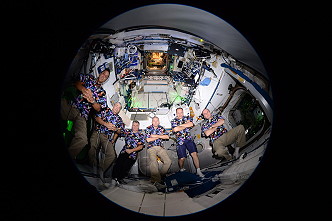 |
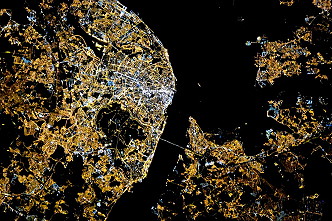 |
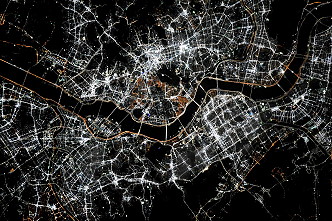 |
 |
 |
 |
 |
 |
 |
 |
 |
 |
 |
 |
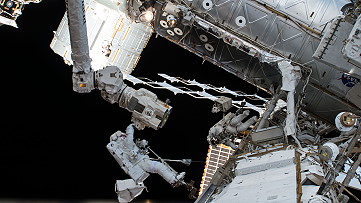 |
 |
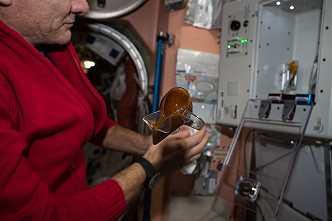 |
 |
 |
 |
 |
 |
 |
 |
 |
 |
 |
 |
 |
 |
 |
more Earth observation photos |
|
more EVA photos |
|
more onboard photos |
|
| © |  |
Last update on November 10, 2023.  |
 |